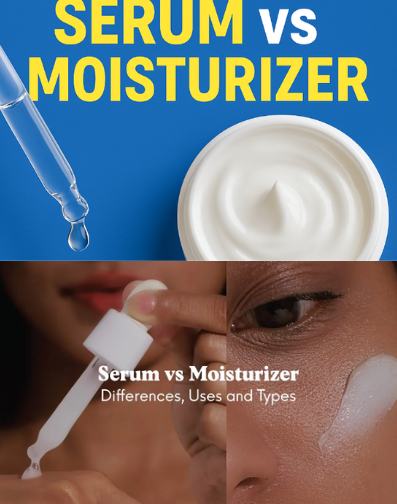
Skincare aisles can feel overwhelming. With so many bottles, jars, and fancy labels, it’s easy to wonder—do I really need both a serum and a moisturizer? While they may look similar, these two products serve very different purposes. Understanding how they work, when to use them, and why they matter could be the game-changer your skin has been waiting for.
How Do Serums and Moisturizers Work on Your Skin?
At first glance, the main difference seems to be texture—serums are usually watery or gel-like, while moisturizers tend to be creamy and thick. But what truly sets them apart is how they interact with your skin.
- Serums are lightweight, fast-absorbing formulas packed with high concentrations of active ingredients. They’re designed to penetrate deeper into the skin, delivering targeted treatment for issues like acne, fine lines, pigmentation, or dehydration.
- Moisturizers, on the other hand, are formulated to strengthen the skin barrier and lock in moisture. They create a protective seal that prevents water loss and shields your skin from environmental stressors like pollution and UV damage.
In short, serums treat specific concerns, while moisturizers protect and maintain your skin’s health.
What Exactly Is a Serum?
Serums are skincare powerhouses. Because they contain smaller molecules and higher concentrations of actives, they reach deeper skin layers more effectively than creams or lotions. That’s why you often see quicker, more noticeable results with a serum.
- Hydrating Serums: Formulas with hyaluronic acid or glycerin plump and hydrate dry or dehydrated skin.
- Anti-Aging Serums: Retinol, peptides, or vitamin C serums stimulate collagen, reducing fine lines and wrinkles.
- Brightening Serums: Vitamin C and niacinamide help fade dark spots and even out skin tone.
- Acne-Fighting Serums: Salicylic acid or glycolic acid clear pores, reduce oiliness, and improve texture.
Clinical studies even show that combining a serum with a moisturizer enhances results, especially for improving elasticity, hydration, and pigmentation.
What Exactly Is a Moisturizer?
Moisturizers are the comfort blanket of your skincare routine. They don’t usually deliver intense treatment, but they’re vital for keeping skin soft, supple, and balanced.
Moisturizers typically contain three types of ingredients:
- Humectants (like glycerin, hyaluronic acid): Pull water into the skin.
- Emollients (like plant oils, shea butter): Smooth and soften by filling in gaps between cells.
- Occlusives (like petrolatum, lanolin, ceramides): Form a barrier to lock water in and protect against external irritants.
By reinforcing the skin barrier, moisturizers help reduce dryness, irritation, and sensitivity, keeping your skin resilient and healthy.
Video : Serums vs Moisturizers: Everything you need to know about Vitamin C and Serums!
3 Main Differences Between Serums and Moisturizers
- Purpose
- Serums: Target specific skin concerns such as hyperpigmentation, acne, or wrinkles.
- Moisturizers: Provide overall hydration and protect your skin barrier.
- Strength of Ingredients
- Serums: Contain higher concentrations of actives (like vitamin C, niacinamide, or salicylic acid).
- Moisturizers: Contain actives too, but usually at lower strengths for daily support and barrier repair.
- Penetration vs. Protection
- Serums: Small molecules penetrate deeper layers of skin for targeted results.
- Moisturizers: Larger molecules sit closer to the surface, locking in hydration and shielding skin.
Should You Use Serums and Moisturizers Together?
The short answer—absolutely. These two products aren’t competitors; they’re teammates. Here’s how to layer them effectively:
- Cleanse: Wash your face with a gentle cleanser.
- Serum: Apply a few drops of serum to deliver targeted treatment. Wait 30–60 seconds for it to absorb.
- Moisturizer: Seal everything in with a moisturizer. This keeps the serum actives in place while locking in hydration.
- Morning Routine: Always finish with sunscreen.
By pairing them, you ensure your skin gets both the treatment it needs and the protection it deserves.
How to Choose the Right Serum and Moisturizer for Your Skin
The right product depends on your skin type and concerns. Here are some common actives and their benefits:
- Vitamin C: Brightens, protects from UV damage, and fights photoaging.
- Niacinamide: Calms inflammation, reduces acne, and evens skin tone.
- Hyaluronic Acid: Deeply hydrates, plumps, and reduces fine lines.
- Salicylic Acid (BHA): Unclogs pores, controls oil, reduces redness.
- Glycolic Acid (AHA): Gently exfoliates, smooths texture, prevents acne.
- Peptides: Support collagen production and overall skin resilience.
Pro tip: Avoid layering ingredients that don’t mix well (like high-strength retinol with vitamin C) unless recommended by a dermatologist.
Video : Serum vs Moisturizer: Here’s the REAL Difference
The Bottom Line
Serums and moisturizers may seem similar, but they’re fundamentally different in purpose and performance. Serums are like the specialists—targeting specific skin concerns with powerful active ingredients. Moisturizers are the guardians—securing hydration, protecting the barrier, and keeping your skin resilient.
For the best results, don’t think of it as serum vs moisturizer. Instead, think of it as serum plus moisturizer. When combined, they amplify each other’s benefits, giving you skin that’s not just treated but also protected, hydrated, and glowing.
Investing a few extra minutes in layering these two steps can transform your skincare routine—and your skin. After all, healthy, radiant skin isn’t just about one magic product; it’s about the perfect partnership.


